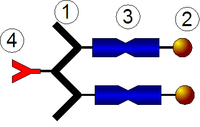
Photo from wikipedia
The self-assembly of protein-polymer conjugates incorporating oligomers of a small, engineered high-affinity binding protein, rcSso7d.SA, is studied to determine the effect of protein oligomerization on nanoscale ordering. Oligomerization enables a… Click to show full abstract
The self-assembly of protein-polymer conjugates incorporating oligomers of a small, engineered high-affinity binding protein, rcSso7d.SA, is studied to determine the effect of protein oligomerization on nanoscale ordering. Oligomerization enables a systematic increase in the protein molar mass without changing its overall folded structure, leading to a higher driving force for self-assembly into well-ordered structures. Though conjugates of monomeric rcSso7d.SA are found to only exist in disordered states, oligomers of this protein linked to a poly( N-isopropylacrylamide) (PNIPAM) block self-assemble into lamellar nanostructures. Conjugates of trimeric and tetrameric rcSso7d.SA are observed to produce the strongest ordering in concentrated solution, displaying birefringent lamellae at concentrations as low as 40 wt %. In highly concentrated solution, the oligomeric rcSso7d.SA-PNIPAM block copolymers exhibit ordering and domain spacing trends atypical from that of most block copolymers. Fluorescent binding assays indicate that oligomerized protein blocks retain binding functionality and exhibit limits of detection up to three times lower than that of surface-immobilized protein sensors. Therefore, oligomerization of the protein block in these block copolymers serves as an effective method to improve both nanoscale ordering and biosensing capabilities.
Journal Title: Biomacromolecules
Year Published: 2018
Link to full text (if available)
Share on Social Media: Sign Up to like & get
recommendations!